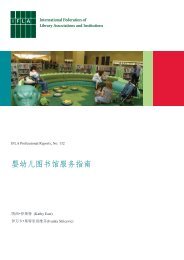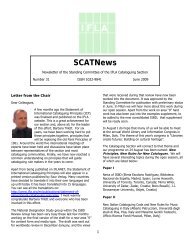World Library and Information Congress, Milan, 2009 - IFLA
World Library and Information Congress, Milan, 2009 - IFLA
World Library and Information Congress, Milan, 2009 - IFLA
You also want an ePaper? Increase the reach of your titles
YUMPU automatically turns print PDFs into web optimized ePapers that Google loves.
350<br />
Bhaskar Mukherjee<br />
by US authors in collaboration with authors<br />
from other countries. Whereas for countries like<br />
the United Kingdom, Canada <strong>and</strong> China the<br />
percentage of international collaboration is<br />
31.63 percent, 34.43 percent <strong>and</strong> 41.18 percent<br />
respectively. The result agrees with the fi ndings<br />
of Frame <strong>and</strong> Carpenter (1979), where they concluded<br />
that the larger a country’s research effort<br />
(the greater the number of its publications) the<br />
smaller is the proportion of international coauthorship<br />
associated with the country.<br />
Further analysis of the authorship pattern by<br />
country indicated that there are 8 countries from<br />
which authors contribute articles only under solo<br />
authorship <strong>and</strong> 10 countries from which authors<br />
contribute articles only under joint authorship.<br />
Authors from these 10 countries are the co-authors<br />
of the remaining 37 countries. On the other h<strong>and</strong>,<br />
there are 3 countries from which authors contribute<br />
articles only with authors from other countries<br />
<strong>and</strong> 16 countries from which authors do not collaborate<br />
with any other country. Sin (2006) pointed<br />
out that researchers could be infl uenced by factors<br />
other than the substantive content of the work<br />
itself. Authors working in reputed organizations<br />
were more likely to be perceived favorably. It may<br />
be that authors in low-income countries might<br />
be placed in a less advantageous position. Nevertheless,<br />
it was gratifying to see publication from<br />
most parts of the globe. Kofi Annan called on the<br />
world’s scientists to close the research <strong>and</strong> development<br />
gap between developed <strong>and</strong> developing<br />
countries (Annan 2003).<br />
Prolifi c Authors <strong>and</strong> their Productivity<br />
Authors’ productivity is defi ned as the number<br />
of papers an author has published within a given<br />
duration. In fact, assessing the importance of<br />
multiple authorship is problematic. Giving every<br />
author of a paper one credit in measuring author<br />
productivity, a total of 2153 authors, including<br />
fi rst author <strong>and</strong> coauthors, were identifi ed from<br />
the articles in JASIST. Table 6 lists 19 prolifi c authors<br />
<strong>and</strong> the number of articles they published<br />
in JASIST during 2000–2007. Each name appears<br />
on 5 or more articles (irrespective of whether<br />
the author is the fi rst named or not). This table<br />
also indicates the number of articles they have<br />
published under single <strong>and</strong> joint authorships.<br />
It is clear from the table that most of the prolifi c<br />
authors contributed their articles in joint authorship.<br />
Among the fi rst 10 prolifi c authors, out<br />
of their 185 publications, 151 articles appeared<br />
in joint authorship <strong>and</strong> 32 articles in single<br />
authorship. Mike Thelwall occupies the first<br />
position with a contribution of 17 articles; 13 of<br />
these appeared under joint authorship. He is<br />
followed by L. Egghe (16 articles), Am<strong>and</strong>a Spink<br />
<strong>and</strong> Ronald Rousseau (both published 14 articles).<br />
Each article of JASIST prints the dates of<br />
submission, fi nal acceptance <strong>and</strong> date of electronic<br />
publication. In most of the cases, the lapse<br />
of time between submission or acceptance <strong>and</strong><br />
publication varies between 8–12 months. So contributions<br />
of more than one article per year in this<br />
8-year period signify that some authors in LIS<br />
have been producing their research papers at a fast<br />
rate. It may also indicate that some authors are<br />
more likely than the others to have their papers<br />
accepted by this journal.<br />
Citations Given versus Citations Received<br />
As indicated in Table 7A, the 975 articles published<br />
in JASIST contained 35,045 references<br />
<strong>and</strong> received 9379 citations up to August <strong>2009</strong>.<br />
The number of references per articles has increased<br />
from 33.43 in 2000 to 41.26 in 2007.<br />
The maximum average number of references per<br />
article was noted in 2007 (about 42 references<br />
per article), <strong>and</strong> the minimum in 2001 (about 31<br />
references per article).<br />
On the other h<strong>and</strong>, articles published in 2000<br />
received the highest number of citations (1762<br />
citations) whereas the lowest was recorded in<br />
respect of articles published in 2007 (525 citations),<br />
followed by articles published in 2005<br />
(792 citations). Overall, the average number of<br />
citations per article is 10.59. There are 103 articles<br />
(10.56 percent) that have not received any citations<br />
up to August <strong>2009</strong>. These articles were<br />
mostly published in 2007 (47 articles) followed<br />
by 2006 (22 articles) <strong>and</strong> 2005 (12 articles). The<br />
average number of references per article increased<br />
by 7.83 from 2000 to 2007 whereas the average<br />
number of citations per article decreased by 13.85<br />
during same period. This implies that the number<br />
of references does not infl uence whether or not<br />
an article attracts citations.<br />
Although the vast changes in publication technology<br />
<strong>and</strong> electronic mail now make it possible to<br />
access articles immediately after publication,<br />
these did not result yet in getting citations faster.<br />
The low number of citations for 2007 may thus<br />
be ignored at this stage, however the numbers

















